 |
 |
 |
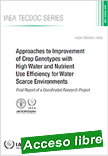 |
Approaches to Improvement of Crop Genotypes with High Water and Nutrient Use Efficiency for Water Scarce Environments - Final Report of a Coordinated Research Project
IAEA TECDOC, 2017, 124 p.
Projected global population increase and the impacts of climate change on agriculture highlight the importance of the use of improved crop varieties coupled with better soil, water and fertilizer management practices designed to protect the natural resource base. This publication is the outcome of a coordinated |
research project (CRP) and focuses on the practical application of nuclear and related techniques, such as mutation induction and the use of stable isotopes of nitrogen [N-15] and carbon [C-13]. The use of such techniques can improve crop productivity with mutant varieties and best-fit soil management practices in diverse agroecological zones affected by drought, high temperatures, water scarcity, soil acidity and soil salinity. The findings of the CRP will be highly valuable to agricultural scientists and laboratory technicians of national agricultural research organizations in Member States as a resource for improving soil and crop productivity.
Extraído de: http://www-pub.iaea.org/books/IAEABooks/12287/Approaches-to-Improvement-of-Crop-Genotypes-with-High-Water-and-Nutrient-Use-Efficiency-for-Water-Scarce-Environments |
 |
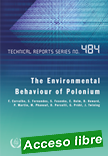 |
The Environmental Behaviour of Polonium
IAEA Technical Reports Series, 2017, 255 p.
This publication covers polonium behaviour in the terrestrial, freshwater and marine environments, dose considerations and mitigation and remediation options. Additionally, case studies are presented. The primary objective is to provide Member States with information for use in the radiological assessment of accidental releases and routine discharges of polonium in the environment, and in remediation planning for areas contaminated by polonium. |
Extraído de: http://www-pub.iaea.org/books/IAEABooks/10845/The-Environmental-Behaviour-of-Polonium |
 |
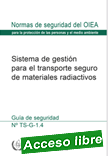 |
Sistema de gestión para el transporte seguro de materiales radiactivos
Colección de Normas de Seguridad del OIEA, 2018, 107 p.
El objetivo de la presente guía de seguridad es proveer orientación sobre la aplicación de los requisitos estipulados en la publicación de Requisitos de Seguridad del OIEA titulada Sistema de gestión de instalaciones y actividades para establecer, aplicar, evaluar y mejorar continuamente un sistema de gestión para el transporte de materiales radiactivos. También proporciona orientación sobre la aplicación de los
|
requisitos establecidos en el Reglamento de
Transporte sobre la garantía de calidad y los programas de garantía de calidad en el contexto del sistema de gestión para el transporte.
Extraído de: https://www-pub.iaea.org/books/IAEABooks/8909/The-Management-System-for-the-Safe-Transport-of-Radioactive-Material |
 |
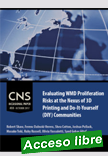 |
This report summarizes the analysis and findings of our research project entitled “Evaluating WMD Proliferation Risks at the Nexus of 3D Printing and Do-It-Yourself (DIY) Communities.” Conducted by a team with the Middlebury Institute of International Studies at Monterey’s (MIIS) James Martin Center for Nonproliferation Studies (CNS), this project builds upon
|
emerging literature in the weapons of mass destruction (WMD) nonproliferation field highlighting additive manufacturing (AM) — which includes 3D printing — as a potential proliferation risk. This project analyzes a set of export-controlled items to understand the degree to which 3D printing might be used to produce — and thus represent a new pathway for proliferators to acquire — dual-use goods useful for the development of WMDs. Additionally the study considers the degree to which communities using and promoting 3D printing may impact the risk of WMD proliferation.
Extraído de: https://www.nonproliferation.org/op33-wmd-proliferation-risks-at-the-nexus-of-3d-printing-and-diy-communities/
|
 |
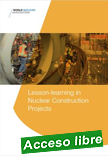 |
Lesson-learning in Nuclear Construction Projects
World Nuclear Association, April 2018, 24 p.
This report reviews and analyses recent nuclear power plant construction projects to identify good practice and lessons learnt. While there are many examples from around the world of nuclear construction projects that have progressed well, several recent cases have seen significant delays and project cost escalation, threatening those projects’ ultimate completion and eroding the appetite for building further nuclear power plants. The World Nuclear Association established a task force on |
lesson-learning to help the nuclear community take advantage of the lessons learned and contribute to the perception of nuclear power among policy-makers, regulators and civil society. The task force sought evidence from World Nuclear Association member companies and reviewed the literature on mega-project outcomes and the findings from regulatory bodies.
The main lesson from recent construction experience is that a collaborative relationship between the project’s sponsor and the top tier contractors provides the foundation for a well-managed project. It allows a wider set of procurement strategies to be employed, encourages knowledge sharing in the planning process and facilitates team working between companies. During execution, appropriate incentives motivate the partners to resolve problems as they arise while discouraging obstructive behaviours that are designed primarily to limit the parties’ individual liability.Wider stakeholder engagement with local communities and taking an accommodative approach towards local community concerns will remove the potential of the project to generate opposition.
Extraído de: http://world-nuclear.org/our-association/publications/online-reports/lesson-learning-in-nuclear-construction-projects.aspx
|
 |
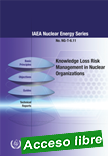
|
Knowledge Loss Risk Management in Nuclear Organizations
IAEA Nuclear Energy Series, 2017, 77 p.
This publication provides a methodology to enable knowledge loss risk management to ensure safe, reliable and efficient operation of nuclear facilities. It focuses on aspects of knowledge loss risks associated with employee attrition and provides guidance to mitigate them. The described methodology has proved itself in nuclear power plants and can be adopted by any other nuclear related organization. The publication also provides examples of best practices (case studies) of effective |
knowledge loss risk management gathered from the nuclear power plants and nuclear related organizations as outlined in annexes I-V.
Extraído de: http://www-pub.iaea.org/books/IAEABooks/10921/Knowledge-Loss-Risk-Management-in-Nuclear-Organizations
|
 |
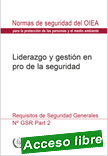 |
Liderazgo y Gestión en pro de la Seguridad
Colección de Normas de Seguridad del OIEA, 2017, 52 p.
El objetivo de la presente publicación de Requisitos de Seguridad es establecer requisitos que respalden el Principio 3 de los Principios fundamentales de seguridad, en relación con el establecimiento, el mantenimiento y la mejora continua del liderazgo y la gestión en pro de la seguridad, así como un sistema de gestión eficaz. Esto es esencial para fomentar y mantener una sólida cultura de la seguridad en una organización.
|
Otro objetivo es establecer requisitos que apliquen el Principio 8, que dice así: “Deben desplegarse todos los esfuerzos posibles para prevenir los accidentes nucleares o radiológicos y para mitigar sus consecuencias”.
Extraído de: http://www-pub.iaea.org/books/IAEABooks/11112/Leadership-and-Management-for-Safety |
 |
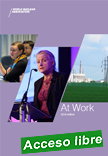 |
World Nuclear Association - At Work: our annual report
World Nuclear Association, 2018, 32 p.
This past year has brought a lot of success for nuclear energy, despite the challenging market conditions that many of us are experiencing.In November, construction started on Bangladesh’s first nuclear power plant at Rooppur. Bangladesh is following the United Arab Emirates and Belarus as the most recent nuclear newcomer country. Soon to follow will be Turkey, where general construction work started at the Akkuyu site in December in preparation for that country’s first nuclear power plant.
|
Also in December, Egypt and Russia signed an agreement to build the first nuclear power plant in North Africa.Nuclear continues to make progress in existing markets. More than 15 GW of new nuclear capacity is expected to start delivering electricity this year, three times the average level seen over the previous 25 years. We look forward to the coming year, with new reactors coming online and nuclear newcomer countries making progress in their programmes.Even where developments are more challenging there has been positive news. In October, the recommendation of the Citizens’ Jury to complete construction of Shin Kori units 5 and 6 in South Korea was a welcome counter to the President’s decision to reduce his country’s reliance on nuclear energy.World Nuclear Association continues to make progress and has seen its membership grow during the course of 2017. There have been major developments with Harmony, the global nuclear industry’s goal for nuclear to supply 25% of global electricity in 2050. The Harmony programme was officially recognized by the International Atomic Energy Agency as the nuclear industry’s target and presented to the ministerial conference in Abu Dhabi in October.It was a big year for our Working Groups, with Cooperation in Reactor Design Evaluation and Licensing (CORDEL) and the OECD’s Multinational Design Evaluation Programme (MDEP) jointly organising the 4th Conference on New Reactor Design Activities in September, making progress towards greater harmonization of reactor licensing requirements.We brought together our information and communication activities into one department to increase efficiency and strengthen our products, including World Nuclear News, the Information Library, strategic communication and media relations.World Nuclear University extended its reach by hosting the School on Radiation Technologies in Brazil, the first time it has ever hosted a leadership course in South America.In terms of getting nuclear on the international agenda, we made outreach efforts to UN Environment, which does not include nuclear in the low-carbon future, and to the World Bank which has an outdated policy excluding nuclear.The Association is gearing up for exciting times. Our World Nuclear Spotlight Conference took place in Indonesia in February 2018, bringing attention to a potential nuclear growth area. We are looking forward to being the industry counterpart in a nuclear Clean Energy Ministerial work stream beginning in May, which complements the Harmony programme. More Working Group reports are due to be published, with the first covering the lessons learned from recent nuclear construction projects. This year World Nuclear University will launch a new programme for executives, the WNU Executive Enhancement course, and organize its 14th Summer Institute, which will be in South Korea. And we will continue to make the case for nuclear internationally, bringing attention to the Harmony goal of 25% nuclear by 2050 and the benefits that this will bring.
Extraído de: http://www.world-nuclear.org/our-association/publications/annual-reports-and-brochures/at-work-annual-report-2018.aspx |
 |
|
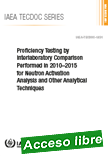
|
Proficiency Testing by Interlaboratory Comparison Performed in 2010–2015 for Neutron Activation Analysis and Other Analytical Techniques
IAEA TECDOC, 2017, 84 p.
The IAEA supports its Member States to increase the utilization of their research reactors. Small and medium sized reactors are mostly used for neutron activation analysis (NAA). Although the markets for NAA laboratories have been identified, demonstration of valid analytical results and organizational quality of the work process are preconditions for expanding the
|
stakeholder community, particularly in commercial routine application of this powerful technique. The IAEA has implemented a new mechanism for supporting NAA laboratories in demonstrating their analytical performance by participation in proficiency testing schemes by interlaboratory comparison. This activity makes possible the identification of deviations and non-conformities, their causes and the process to implement effective approaches to eliminate them. Over 30 laboratories participated between 2010 and 2015 in consecutive proficiency tests organized by the IAEA in conjunction with the Wageningen Evaluating Programmes for Analytical Laboratories (WEPAL) to assess their analytical performances. This publication reports the findings and includes lessons learned of this activity. An attached CD-ROM contains many individual participating laboratory papers sharing their individual results and experience gained through this participation.
Extrído de: http://www-pub.iaea.org/books/IAEABooks/12290/Proficiency-Testing-by-Interlaboratory-Comparison-Performed-in-2010-2015-for-Neutron-Activation-Analysis-and-Other-Analytical-Techniques
|
 |
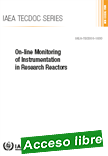 |
On-line Monitoring of Instrumentation in Research Reactors
IAEA TECDOC, 2017, 80 p.
This publication is a result of the coordinated research project (CRP) entitled ‘Improved I&C Maintenance Techniques for RRs’ whose main goal was to produce the technical foundation for implementation of OLM On-line monitoring (OLM) to optimize the frequency of calibration of process and nuclear instrumentation channels for Research reactors (RRs). The objectives of the CRP were to: a) Compile technologies, standards, regulations,
|
and guidelines on OLM for calibration monitoring; b) Survey current procedures, database of existing process instrumentation, historical data and available means of performing OLM in RRs.
The time to embrace this strategy has come and most of the work including the
development of the regulatory basis for OLM has already been established for NPP. In particular, the issues related to technical and regulatory aspects, implementation, quality assurance, and risk assessment have been addressed for power reactors and can be referenced in developing OLM technologies for RRs.
The main objectives of this TECDOC are: a) to explain OLM techniques including data acquisition, data qualification and data analysis for improving performance of RRs; b) to provide the technical foundation and the guidance for implementation of OLM for RRs and c) to present regulatory aspects related to implementation of OLM.
Extraído de: http://www-pub.iaea.org/books/IAEABooks/12274/On-line-Monitoring-of-Instrumentation-in-Research-Reactors
|
 |
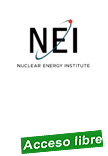 |
Nuclear Costs in Context
Nuclear Energy Institute (NEI - US), August 2017, 6 p.
This paper describes the cost drivers for generating electricity using nuclear
energy—capital, operations and fuel costs—and the economic pressures facing nuclear
plants and the impacts of closing them prematurely. In 2016, the average total generating cost for nuclear energy was $33.93 per MWh
(megawatt-hour).
As a result of capital investments by industry, 84 of the 99 operating reactors have
received 20-year license renewals and 92 of the operating reactors have been approved
|
for uprates that have added more than 7,300 megawatts of capacity.
A combination of policy and economic factors has led to the premature closure of
several highly reliable plants (/advocacy/preserve-nuclear-plants) with high capacity
factors and relatively low generating costs.
Additional plants will face the prospect of early closure unless policies that value the
benefits of nuclear energy (/advantages) are put in place.
Allowing nuclear plants to close will have long-term economic consequences:
replacement generating capacity, when needed, will produce more costly electricity,
fewer jobs that will pay less, and more pollution.
Extraído de:https://www.nei.org/resources/reports-briefs/nuclear-costs-in-context
|

|
|
|
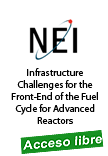 |
Infrastructure Challenges for the Front-End of the Fuel Cycle for Advanced Reactors
Nuclear Energy Institute (NEI - US), January 2018, 35 p.
New reactors are urgently needed. Without them the contribution of nuclear power to the United States’ energy needs will decrease over the next several decades.
The vast majority of new designs require a new fuel production chain that doesn’t exist today. The length of time it takes to gain commercial support for funding, address technical and regulatory issues, and then construct the necessary fuel-cycle infrastructure
|
creates special challenges for bringing advanced reactors to market.
In order to address these challenges government coordination and support from the
Department of Energy is essential to realizing the benefits associated with the use of advanced reactors in the United States.
Extraído de:https://www.nei.org/resources/reports-briefs/infrastructure-for-the-front-end-fuel-cycle
|
| |
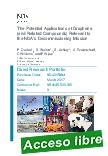 |
The Potential Applications of Graphene (and Related Compounds) Relevant to the NDA's Decommissioning Mission
Nuclear Decommissioning Authority (NDA - UK), 13 July 2017, 95 p.
Overview of research and development regarding the properties and potential opportunities of using graphene and related materials in nuclear decommissioning.
|
Extraído de:https://www.gov.uk/government/publications/graphene-and-its-use-in-nuclear-decommissioning
|
| |
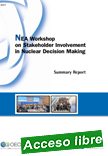 |
NEA Workshop on Stakeholder Involvement in Nuclear Decision Making - Summary Report
Nuclear Energy Agency (NEA), 16/10/17, 83 p.
Because nuclear issues are embedded in broader societal issues such as the environment, energy, risk management, health policy and sustainability, they can often generate considerable interest and concern. Actors involved in the nuclear energy sector, including regulators, governments and licensees, share the goal of reaching accepted, sustainable decisions and to ensure that the decision-making process is transparent.
|
Stakeholder involvement in decision making is today seen as an essential means for improving decisions and for optimising their implementation.
In this context, the Nuclear Energy Agency (NEA) organised a Workshop on Stakeholder Involvement in Nuclear Decision Making in January 2017, acknowledging that different countries and sectors may face similar challenges and that sharing experiences and approaches could be useful. The workshop was an opportunity to bring together experts with first-hand knowledge and experience in areas related to nuclear law, regulatory practices, radiological protection, nuclear waste management, the deployment of new nuclear facilities, extended operation of nuclear facilities, deployment of other energy technologies and infrastructures, and social and traditional media.
This summary report attempts to capture the collective wisdom generated over three days of interaction. It highlights some commonalities and differences in views and approaches, and identifies particular lessons that can be applied to improve the strategy and practice of involving stakeholders in decisión making. Overall, the learning gained from this workshop can benefit governments and citizens alike.
Extraído de:http://www.oecd-nea.org/tools/publication?query=&div=&lang=&period=6m&sort=title&filter=1#p7302
|
| |
| |
|
|
|
